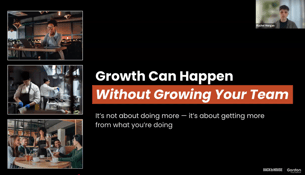Across the past three years, restaurants launched new CPG lines like never before. It’s a strategy that restaurants are increasingly taking to diversify revenue and increase overall financial stability.
In a recent report by Square surveying 1,000 restaurants and 2,000 consumers, 21% of restaurants’ revenue, on average, came from products and services outside of core restaurant offerings. In that same report, 87% of restaurants said they plan to expand non-core offerings, like retail goods. Meanwhile, 57% of consumers surveyed said they’ve purchased retail items at a local restaurant in the past year, indicating a promising return on investment for restaurants with the right audience and marketing.
But how does a restaurant successfully market their CPG line as the competition continues to grow? To get some advice, we reached out to Here Here Market, a marketplace that works with restaurants and chefs to help them sell their packaged goods.
Here are some tips designed to help any restaurant get the most out of their CPG line.
Tips for marketing your restaurant’s CPG line to increase ROI
Do your research before turning a restaurant item into a packaged product.
An obvious place to start is to look at your restaurant’s existing top sellers. If your customers are showing high demand for a product, whether it’s a hot sauce, a spice mix, or a full-on appetizer, that’s an indicator that might perform well elsewhere, too.
“You can start there, but then you have to figure out if it’s packageable and look at logistical considerations, like if it can be made shelf-stable and not spoil upon shipping,” says Here Here co-founder Nick Florek.
Another factor to consider is the consumer trends that are currently dominating the market. Do some research to see what people are searching for online. If you plan to work with a third-party marketplace like Here Here, often they can provide guidance on what types of products are currently performing best.
Consider your signature sauces.
Some of the highest-selling items in Here Here’s marketplace are sauces. “For people who like to cook, sauces add a cheffy, culinary touch to a meal with a lot less time,” says Florek.
Products that do exceptionally well tend to meet an underserved need in the market. For example, Florek notes that one of Here Here’s top-performing sauces is a vegan nacho sauce, noting the popularity uptick in vegan food but the lack of manufacturers making quality plant-based nacho dips.
Invest in defining and differentiating your brand.
Most culinary marketplaces are filled with products. Goldbelly, for example, works with 1,000-plus restaurants, and Here Here has more than 800 products on its site. The competition makes it essential to craft a strong brand voice and know how to clearly communicate the features of your product that make it different from others on the market.
“You have to really understand who your target customer is and brand around that, and then really invest into that branding,” says Florek. “The most success we see is when people are actively resharing their products on Instagram and TikTok.”
Pressure test your packaging.
Packaging – from the materials to the colors to the wording – is a huge part of defining a brand.
“There’s a reason big CPG companies invest tons of money into packaging,” says Florek. “Your product has to stand out in a sea of other products, and so you need eye-catching packaging, a catchy name that resonates with people and says what the product is in a clear way, and a clear description of the product.”
Florek recommends creating a few different label designs and then consumer testing them. Pull together a group of people outside of the brand, and ask questions like, “Was it clear what the product is?”, “Does looking at this product entice you to buy it?”, “What would you expect to be in a jar with that label?”, and “How do you feel about the overall packaging design?”
“Otherwise, you’re just guessing based on one persons’ opinion, which never usually leads to as much success,” says Florek.
Start small.
Launching one product at a time allows you to stay more fluid and adjust your brand based on market feedback.
“We see it across the board, 20% of products sell better than the other 80%, so it’s helpful to start with a couple of focused products, and then you can understand what customers are resonating with and build from there,” says Florek.
Obviously you’ll want to analyze your sales numbers, but it’s also important to read customer reviews and stay abreast of how saturated the market is and what people are specifically searching for.
Have dedicated CPG staff.
Even if you’re launching just one CPG product, it’s important to designate a staff member to oversee the operations.
“If you want to be successful, you have to consider it a true revenue stream, not just something that’s fun or you’re playing around with,” says Florek. “You should set true revenue targets, with milestones every six months, and if you’re not meeting those milestones, you should ask why.”
Early on, if sales are slow, read through any initial customer reviews and also take another look at your marketing approach. Are enough people even aware of your product? Give yourself a grace period to monitor sales and make a few adjustments. If you continue to adapt but sales remain down, it’s time to pivot and find a different market, says Florek.
Hire a professional to photograph your product.
Photography plays a crucial role in making products stand out in a crowded digital world.
“Food is very tactile – you want to touch it, you want to eat it. When you can’t do that, the next way to engage is with your eyes,” says Florek. “The more the product looks appealing and customers can see it in use, the more they’re intrigued to make a purchase and try it.”
Invest in a photographer who has experience with product photography, is comfortable using commercial lighting, and knows how to shoot products against a background and make words and labels stand out.
Market your product across all channels.
Get sales rolling by tapping into your restaurant’s existing customer base. This is where you’re likely to maximize sales, making it essential to inform current customers about your CPG offerings and where to purchase them.
“We recommend using all of your channels, both email and social, to share the products you’re launching,” says Florek. “Social media’s literally built for resharing.”
Add a link to your products in your Instagram and TikTok bios, and put a tab on your website that redirects people to shop online. Build CPG announcements in your existing email campaigns, and also consider how you can market your products in-store.
“One thing we’re testing with a partner is putting QR codes on receipt sleeves,” says Florek. “In those moments where customers had a great dining experience, they can extend that relationship just by scanning a QR code and getting a product to use at home.”
Consider hiring a public relations rep.
Beyond doing self-promotion, it’s helpful to team up with others who can spread the word even further. While you could consider working with social media influencers, Florek suggests working with public relations reps that can land your product in well-known or niche publications.
“With influencers, it can be challenging to gauge the quality of their audience, and just because someone has thousands of followers doesn’t mean those people will buy the product,” says Florek. “We’ve put more money into PR because we tend to see more response from a purchase behavior standpoint when the product’s written about by someone with media authority, whether that’s the Today show or Eater or Women’s Health.”
Interested in learning how to get your CPG products on Here Here Market? Email team@hereheremarket.com.





